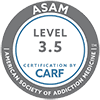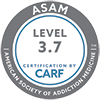 When a person suffers from anxiety disorder, panic disorder, seizures, and social phobias, or has trouble with insomnia, their health care professional might prescribe clonazepam, sometimes referred to by the brand name Klonopin. Clonazepam/Klonopin is a controlled substance that might cause physical and emotional dependence.
When a person suffers from anxiety disorder, panic disorder, seizures, and social phobias, or has trouble with insomnia, their health care professional might prescribe clonazepam, sometimes referred to by the brand name Klonopin. Clonazepam/Klonopin is a controlled substance that might cause physical and emotional dependence.
Facts About Clonazepam
Clonazepam is in a category of pharmaceuticals known as benzodiazepines, a central nervous system depressant. This long-acting drug is designed to alter neurotransmitter activity in the brain—specifically, to activate gamma-aminobutyric acid (GABA). Scientists believe that people who experience anxiety, seizures, and insomnia have excessive brain activity. Clonazepam works to release more GABA to produce a calming effect on over-stimulated neurotransmitters.
WebMD states that benzodiazepines “act on the central nervous system, produce sedation and muscle relaxation, and lower anxiety levels.” While benzodiazepines like clonazepam don’t cure particular conditions, they’re often prescribed in low doses to help manage them. These conditions include:
- Alcohol withdrawal
- Akathisia (restless movement)
- Anxiety disorder
- Insomnia
- Panic disorder
- Seizure control
Some physicians might also use clonazepam or another benzodiazepine to induce amnesia for uncomfortable procedures or prior to surgical procedures requiring anesthesia.
A health care provider such as a physician or mental health professional usually prescribes clonazepam or Klonopin in doses ranging from 0.125 mg to 2 mg. Depending on an individual’s treatment and response to the drug, their prescribed dosage might also vary by type of tablet—oral or disintegrating oral—and the number of times a day they take it.
Clonazepam Side Effects
Although clonazepam is considered safe for long-term use when used as directed, the National Alliance on Mental Illness (NAMI) reports that it produces both common and serious side effects.
Common side effects:
- Dizziness
- Drowsiness
- Fatigue
- Impaired coordination
- Lightheadedness
- Trouble concentrating
NAMI points out that most people only experience these issues for a short period of time when they first take clonazepam, and that the effects usually dissipate after a couple of weeks.
Serious side effects:
- Allergic reaction
- Depression
- Excessive sweating
- Extreme fatigue or passing out
- Headaches
- Increased heart rate
- Irritability
- Memory impairment
- Shortness of breath
- Sleep driving, eating, or walking
- Suicide ideation
- Trouble speaking
- Unusual behavior or changes in mood
Clonazepam side effects increase when taken with alcohol, as well as other prescription and over-the-counter medication, and especially illicit drugs.
Clonazepam Dependency
Similar to Ativan (known generically as lorazepam), another benzodiazepine used to manage anxiety disorder, clonazepam often has an immediate effect on the brain. This might result in physical or emotional dependency—sometimes as soon as within two weeks of use. Physical dependency means there will be withdrawal when the drug is stopped.
Consequently, Klonopin and clonazepam are classified as Schedule IV prescription drugs by the U.S. Drug Enforcement Administration. This means they have “an accepted medical use but may also cause physical or psychological dependence and may be abused.”
Although Klonopin and clonazepam don’t have wide reputations as street drugs, some people become addicted to their peaceful, calming effects. Other names for it include K-Cuts, K-Pins, pins, and super Valium.
Clonazepam Withdrawal
Under no circumstances should a person stop taking clonazepam or Klonopin without first talking to their attending health care provider and developing a supervised plan for tapering off the medication. This helps them avoid more severe clonazepam withdrawal consequences such as:
- Extreme stomach or muscle cramps
- Hallucinations
- New or worsening seizures
- Uncontrollable shaking in one or more parts of the body
Clonazepam Treatment Starts with Detox
If someone develops an addiction to clonazepam or Klonopin, it’s imperative to not only help them recover from it, but also develop a more comprehensive management plan for their underlying condition.
At Twin Lakes Recovery Center, our board certified medical team works to first stabilize individuals with a gradual reduction method and reduce the impact of clonazepam withdrawal symptoms such as:
- Agitation
- Heightened anxiety
- Extreme sleeplessness
- Increased heart rate
- More frequent panic episodes
- Possibility of additional seizures
Depending on the initial clonazepam dosage or the level of addiction, especially if alcohol or other substances are involved, detoxification and withdrawal might take 2-4 weeks.
During this time, addiction specialists will also address primary conditions, such as anxiety or panic disorder, as well as insomnia, and help the client develop better coping mechanisms while also considering the possibility of a different control medication. Some methods for managing these conditions might have nothing to do with medication but contribute greatly to an individual’s overall well-being, such as:
- Animal-assisted therapy
- Breathing exercises
- Cognitive behavioral and other forms of therapy
- Holistic therapies
- Mindfulness and meditation
- Nature wellness
If someone was prescribed clonazepam or Klonopin to control seizures, our medical professionals will examine the cause and effect of the condition, and possibly recommend another medication with fewer adverse effects.
To learn how the whole-person approach at Twin Lakes provides a healthier future in recovery, please talk with one of our admission specialists, day or night.



